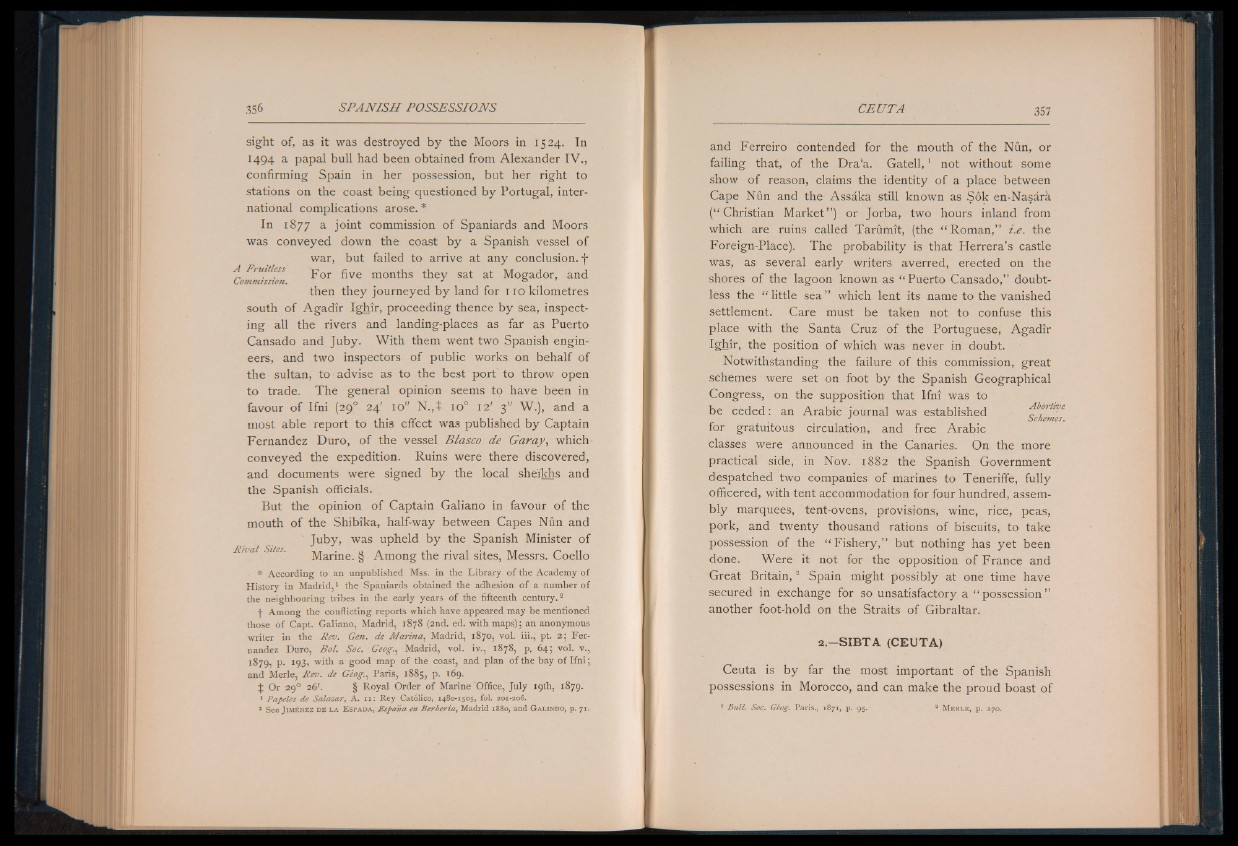
sight of, as it was destroyed by the Moors in 1524. In
1494 a papal bull had been obtained from Alexander IV.,
confirming Spain in her possession, but her right to
stations on the coast being questioned by Portugal, international
complications arose. *
In 1877 a joint commission of Spaniards and Moors
was conveyed down the coast by a Spanish vessel of
war, but failed to arrive at any conclusion, f
A Fruitless p or f¡ve months they sat at Mogador, and
Commission. f °
then they journeyed by land for 110 kilometres
south of Agadir Ighir, proceeding thence by sea, inspecting
all the rivers and landing-places as far as Puerto
Cansado and Juby. With them went two Spanish engineers,
and two inspectors of public works on behalf of
the sultan, to advise as to the best port' to throw open
to trade. The general opinion seems to have been in
favour of Ifni (290 24' 10" N .,t io° 12' 3" W.), and a
most able report to this effect was published by Captain
Fernandez Duro, of the vessel Blasco de Garay, which
conveyed the expedition. Ruins were there discovered,
and documents were signed by the local sheikhs and
the Spanish officials.
But the opinion of Captain Galiano in favour of the
mouth of the Shibika, half-way between Capes Nun and
Juby, was upheld by the Spanish Minister of
Marine. § Among the rival sites, Messrs. Coello
* According to an unpublished Mss. in the Library of the Academy of
History in Madrid,1 the Spaniards obtained the adhesion of a number of
the neighbouring tribes in the early years of the fifteenth century.2
f Among the conflicting reports which have appeared may be mentioned
those of Capt. Galiano, Madrid, 1878 (2nd. ed. with maps); an anonymous
writer in the Rev. Gen. de Marina, Madrid, 1870, vol. iii., pt. 2; Fernandez
Duro, Bol. Soc. Geog., Madrid, vol. iv., 1878, p. 64; vol. v.,
1879, p. 193, with a good map of the coast, and plan of the bay of Ifni;
and Merle, Rev. de Geog., Paris, 1885, p. 169.
t Or 290 26'. § Royal Order of Marine Office, July 19th, 1879-
1 Papeles de Salazar, A. 1 1 : Rey Católico, 1480-1505, fo l. 201-206.
2 S e e J im é n e z d e l a K s p a d a , Empana en Berbería, M a d r id 1880, a n d G a l in d o , p . 7 1 .
and Ferreiro contended for the mouth of the Nun, or
failing that, of the Dra'a. Gatell,1 not without some
show of reason, claims the identity of a place between
Cape Nun and the Assaka still known as Sok en-Nasara
(“ Christian Market” ) or Jorba, two hours inland from
which are ruins called Tarumit, (the “ Roman,” i.e. the
Foreign-Place). The probability is that Herrera’s castle
was, as several early writers averred, erected on the
shores of the lagoon known as “ Puerto Cansado," doubtless
the “ little sea ” which lent its name to the vanished
settlement. Care must be taken not to confuse this
place with the Santa Cruz of the Portuguese, Agadir
Ighir, the position of which was never in doubt.
Notwithstanding the failure of this commission, great
schemes were set on foot by the Spanish Geographical
Congress, on the supposition that Ifni was to
be ceded: an Arabic journal was established Aboitive J schemes.
for gratuitous circulation, and free Arabic
classes were announced in the Canaries. On the more
practical side, in Nov. 1882 the Spanish Government
despatched two companies of marines to Teneriffe, fully
officered, with tent accommodation for four hundred, assembly
marquees, tent-ovens, provisions, wine, rice, peas,
pork, and twenty thousand rations of biscuits, to take
possession of the “ Fishery,” but nothing has yet been
done. Were it not for the opposition of France and
Great Britain,3 Spain might possibly at one time have
secured in exchange for so unsatisfactory a “ possession”
another foot-hold on the Straits of Gibraltar.
2.-SIBTA (CEUTA)
Ceuta is by far the most important of the Spanish
possessions in Morocco, and can make the proud boast of